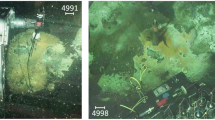Play all audios:

ABSTRACT We have recently found many light hydrocarbons, both alkanes and alkenes, in trace amounts (ng compound per g sediment) in Recent marine sediments1–4. These hydrocarbons are
believed to originate from both biological and low-temperature reactions in the sediments. Understanding their mechanism of formation may allow use of these compounds to decipher the past
biological and thermal history of the sediments4. To investigate biological origins, we have cultivated mixed populations of bacteria on natural terpenoids and found, as degradation
products, both alkanes and alkenes in the C1–C7 range; this is the first report of C4–C7 hydrocarbons being formed from microbial activities. Aerobic followed by anaerobic degradation
yielded mainly small amounts of straight-chain alkenes. No such products resulted from blanks or controls. The results are consistent with products observed in natural environments. Access
through your institution Buy or subscribe This is a preview of subscription content, access via your institution ACCESS OPTIONS Access through your institution Subscribe to this journal
Receive 51 print issues and online access $199.00 per year only $3.90 per issue Learn more Buy this article * Purchase on SpringerLink * Instant access to full article PDF Buy now Prices may
be subject to local taxes which are calculated during checkout ADDITIONAL ACCESS OPTIONS: * Log in * Learn about institutional subscriptions * Read our FAQs * Contact customer support
SIMILAR CONTENT BEING VIEWED BY OTHERS STERANE AND HOPANE BIOMARKERS CAPTURE MICROBIAL TRANSFORMATIONS OF COMPLEX HYDROCARBONS IN YOUNG HYDROTHERMAL GUAYMAS BASIN SEDIMENTS Article Open
access 28 October 2022 PAH CONTAMINATION IN COASTAL SURFACE SEDIMENTS AND ASSOCIATED BACTERIAL COMMUNITIES Article Open access 23 November 2024 THERMOGENIC HYDROCARBON BIODEGRADATION BY
DIVERSE DEPTH-STRATIFIED MICROBIAL POPULATIONS AT A SCOTIAN BASIN COLD SEEP Article Open access 17 November 2020 REFERENCES * Hunt, J. M. _Nature_ 245, 411 (1975). Article ADS Google
Scholar * Whelan, J. K. _Init. Rep. DSDP_ 47A, 531 (1979). Google Scholar * Hunt, J. M. & Whelan, J. K. _Org. Geochem._ 1, 219 (1979). Article CAS Google Scholar * Whelan, J. K.,
Hunt, J. M. & Berman, J. _Geochim. cosmochim. Acta_ (in the press). * Ferry, J. G. & Wolfe, R. S. _Microbiology_ 107, 33 (1976). CAS Google Scholar * Lyman, J. & Fleming, R. H.
_J. Mar. Res._ 3, 134 (1940). CAS Google Scholar * Willingham, C. A. & Oppenheimer, C. H. _J. Bact._ 88, 541 (1964). Article CAS Google Scholar * Day, W. C. & Erdman, J. G.
_Science_ 141, 808 (1963). Article ADS CAS Google Scholar * Lijmbach, G. M. G. _Proc. 9th World Petroleum Congr._ 2, 357–369 (1975). CAS Google Scholar Download references AUTHOR
INFORMATION AUTHORS AND AFFILIATIONS * Woods Hole Oceanographic Institution, Woods Hole, Massachusetts, 02543 John M. Hunt, Robert J. Miller & Jean K. Whelan Authors * John M. Hunt View
author publications You can also search for this author inPubMed Google Scholar * Robert J. Miller View author publications You can also search for this author inPubMed Google Scholar * Jean
K. Whelan View author publications You can also search for this author inPubMed Google Scholar RIGHTS AND PERMISSIONS Reprints and permissions ABOUT THIS ARTICLE CITE THIS ARTICLE Hunt, J.,
Miller, R. & Whelan, J. Formation of C4–C7 hydrocarbons from bacterial degradation of naturally occurring terpenoids. _Nature_ 288, 577–578 (1980). https://doi.org/10.1038/288577a0
Download citation * Received: 14 July 1980 * Accepted: 14 October 1980 * Issue Date: 11 December 1980 * DOI: https://doi.org/10.1038/288577a0 SHARE THIS ARTICLE Anyone you share the
following link with will be able to read this content: Get shareable link Sorry, a shareable link is not currently available for this article. Copy to clipboard Provided by the Springer
Nature SharedIt content-sharing initiative
